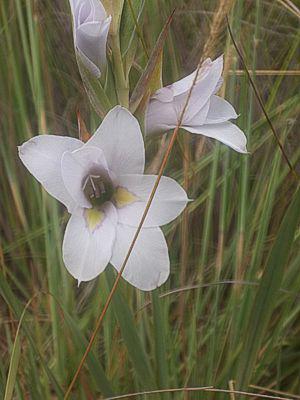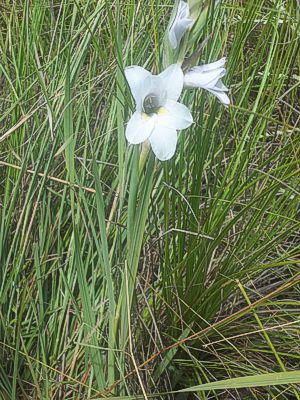Gladiolus rehmannii
Gladiolus rehmannii Baker
Family: Iridaceae
Common names: Bushveld gladiolus (Eng.); bosveldpypie (Afr.)
Introduction
Gladiolus rehmannii is a very attractive garden plant, forming part of the tremendous diversity within the Iris family. It has large, white to pale mauve flowers.

Description
Description
Gladiolus rehmannii is a plant predominantly suited to dry bushveld conditions, with a height of 300–500 mm, a corm that is globose (meaning spheroid or round in outline), leaves narrowly sword-shaped to linear, with a moderately thickened midrib and an erect stem sometimes flexed outwards.
Flowers are unscented, white to pale lilac, the lower or all three lower tepals with yellow nectar guides in the lower midline, sometimes outlined in light purple. Flowering time is mid-January to March. Seeds are ovate-oblong, 12–14 × 7–8 mm, translucent reddish brown, broadly and evenly winged.
Conservation Status
Status
According to the Red List of South African plants, Gladiolus rehmannii is assessed as Least Concern (LC).
Distribution and habitat
Distribution description
Gladiolus rehmannii is a summer-rainfall species in southern Africa and is largely restricted to the bushveld of the northern parts of South Africa. It extends from Sybrandskraal near Groblersdal across the Limpopo Province and the northern part of North West Province to eastern Botswana. Collections indicate that is particularly common on the Waterberg between Nylstroom and Thabazimbi. Plants grow in sandy soils, often in rocky ground, in light woodland that is frequently dominated by Faurea saligna.

Derivation of name and historical aspects
History
The word Gladiolus is Latin for ‘little sword’, and the name alludes to the flattened, sword-shaped leaves, actually a characteristic of the entire Iris family.
Gladiolus rehmannii was discovered by the Polish botanist, Anton Rehmann in 1879 or 1880, when he travelled in the north of what was then the Transvaal Republic. Rehmann’s specimen at the Kew Herbarium in London was described by J.C. Baker in 1982 and named in Rehmann’s honour.
Ecology
Ecology
The large flowers of Gladiolus rehmannii have short perianth tubes, and despite their white colouring and inconspicuous, cream-coloured nectar guides, they are adapted for pollination by the same anthophorid bees that pollinate most other eastern southern African species of the genus.

Uses
Use
Gladiolus rehmannii has no known traditional or medicinal uses, but is highly regarded and valued as an attractive garden plant and as a cutflower.
Growing Gladiolus rehmannii
Grow
Gladiolus rehmannii is a summer-growing Gladiolus, requiring a more humus-rich, less well-drained medium and more regular drenching during the growing period than winter growers. Propagation is by sowing of seed in spring and by separation of corm offsets and cormlets in winter. Plant corms in spring (about September) and give plenty of water all through the growing season. Corms are best planted in open ground, rather than pots, roughly 10 cm deep and 15 cm apart.
Summer-growing Gladiolus species such as G. rehmannii, are particularly susceptible to a wide range of pests, such as aphids which attack developing inflorescences, thrips which results in deformed flowers and red spider mites which infect the leaf surfaces, as does rust fungus.
References
- Duncan, G. 2010. Grow bulbs. Kirstenbosch Gardening Series. South African National Biodiversity Institute, Cape Town.
- Goldblatt, P. & Manning, J. 1998. Gladiolus in southern Africa. Fernwood Press, Vlaeberg, Cape Town.
- Lewis, G.J., Obermeyer, A.A. & Barnard, T.T. 1972. Gladiolus: a revision of the South African species. Journal of South African Botany Suppl. 10
- http://Redlist.sanbi.org
Credits
Malesolo Magoele
Millennium Seed Bank Partnership
May 2015
Plant Attributes:
Plant Type: Bulb
SA Distribution: Limpopo, Mpumalanga, North West
Soil type: Sandy, Loam
Flowering season: Late Summer
PH: Acid, Neutral
Flower colour: White, Mauve/Lilac
Aspect: Full Sun, Morning Sun (Semi Shade)
Gardening skill: Average
Special Features:
Horticultural zones









Rate this article
Article well written and informative
Rate this plant
Is this an interesting plant?
Login to add your Comment
Back to topNot registered yet? Click here to register.